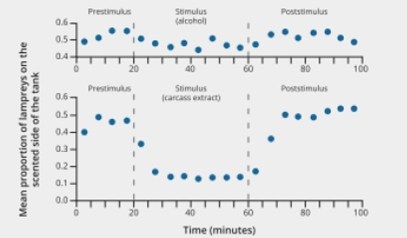
Concept explainers
Deathly Lamprey Repellent Predation by sea lampreys on native fishes in the Great Lakes is an ongoing problem. To help solve it, Michael Wagner and his team test methods of repelling lampreys. They carried out an experiment to investigate reports that sea lampreys detect the scent of lamprey carcasses and tend to avoid them. The researchers made alcohol-based lamprey carcass extracts, then observed what happened when lampreys were put in tanks and exposed to either this extract or to alcohol alone. FIGURE 25.6 shows their results.

FIGURE 25.6 Effectiveness of carcass extracts as a lamprey repellent.
Mean proportion of lampreys on the scented side of the test tank during B trials with 10 lampreys. Lampreys were placed in the tank for 20 minutes before exposure to alcohol or carcass extract and remained there for 40 minutes after exposure. The upper graph shows results with alcohol as the stimulus; the lower shows the results with carcass extracts. Bars indicate standard error.
Why was it necessary to test the response of lampreys to the scent of alcohol alone?
To explain: The reason why it is necessary to test the response of lampreys to the scent of the alcohol alone
Concept introduction: Sea lampreys are chordates that are classified as jawless fishes and are major parasitic carnivorous chordates. The sea lampreys are pests in the Great lakes of the USA as they cause loss of several commercial fishes.
Explanation of Solution
In order to reduce the menace of the lampreys, Scientist M and his team designed an experiment to investigate and report that sea lampreys detect the scent of other lamprey carcasses and have the nature to avoid them. The team used alcohol-based extracts of lamprey carcasses. They then observed the results when lampreys were put in two tanks: one with the alcohol-based extract and another with alcohol alone.
The alcohol serves as a control. The lampreys should not have any reaction towards alcohol as they are the additional substance present along with the tissue extract of lamprey carcass. Therefore, it is necessary to confirm that lampreys are not attracted to the scent alcohol.
The lampreys exposed to alcohol alone in the tank will help us to confirm if the lampreys are attracted to the carcass alone or both alcohol and carcass combined.
Want to see more full solutions like this?
Chapter 25 Solutions
Biology: The Unity and Diversity of Life (MindTap Course List)
Additional Science Textbook Solutions
SEELEY'S ANATOMY+PHYSIOLOGY
General, Organic, and Biological Chemistry - 4th edition
Introductory Chemistry (6th Edition)
Chemistry: Atoms First
Genetics: From Genes to Genomes
- 4arrow_forwardDoes it show the level of proteins? What about the amount? Levels of protein activation? How can you tell? Does the thickness tell you anything? What about the number of the lines? And the other questionsarrow_forwardKD 200- 116- 66- Vec ATF6 (670) ATF6 (402) ATF6 (373) ATF6 (366) I I 45- 1 2 3 4 5 ATFG (360) (e/c) 9V ATFG (402) g ant- ATF anti-KDEL DAPI barrow_forward
- Western blot results: what information can you get? Presence of proteins of your interest Levels of protein expression Levels of protein activation (must use activation state-specific antibody) Decreased function of the ATM kinase in aging mice. A C57BL/6 female 6 month Con IR 20 month C57BL/6 male 6 month 28 month Con IR Con IR Con IR p-ATM (S1981) ATM P-p53 (ser18) Actinarrow_forwardDoes it show the level of proteins? What about the amount? Levels of protein activation? How can you tell? Does the thickness tell you anything? What about the number of the lines?arrow_forwardWB: Protein of interest visualized by fluorescent Protein A Protein Barrow_forward
- Question #4: Assume you are able to use CRISPR to create an allele that will convert a cross-pollinated, sexually reproducing crop plant into an obligate apomict. Your edited obligate apomict plants retains all the CRISPR "machinery" necessary to convert the "sexually reproducing" allele to the "obligate apomict" allele. You plant 100 hectares of your edited obligate apomicts in order to increase seed for sale the following year. Neighboring farms and seed producers are growing many different un-edited sexually reproducing varieties of the crop. If your neighbors plant seed harvested from their crops that was pollinated by your crop, should they expect these seeds to generate apomictic or non-apomictic plants? Type your answer here:arrow_forwardcalculate the questions showing the solution including variables,unit and equations all the questiosn below using the data.show solving and answer a) B1, b) B2, c) hybrid rate constant (1) d) hybrid rate constant (2) e) t1/2,dist t1/2,absorb f) t1/2,elim k) apparent central compartment volume (V1,app) p) total AUC (using short cut method) apparent volume of distribution based on AUC (VAUC,app) apparent clearance (CLapp) absolute bioavailabilty of oral route ( AUCiv =116ml)arrow_forwardPlease help me to draw this by hand. In as much detail as possible, hand draw a schematic diagram of the hypothalamic-pituitary-gonad (HPG) axis in the human female. Be sure to include all the relevant structures and hormones. You must define all abbreviations the first time you use them. Please include (and explain) the feedback loops.arrow_forward
 Biology: The Unity and Diversity of Life (MindTap...BiologyISBN:9781305073951Author:Cecie Starr, Ralph Taggart, Christine Evers, Lisa StarrPublisher:Cengage Learning
Biology: The Unity and Diversity of Life (MindTap...BiologyISBN:9781305073951Author:Cecie Starr, Ralph Taggart, Christine Evers, Lisa StarrPublisher:Cengage Learning Biology Today and Tomorrow without Physiology (Mi...BiologyISBN:9781305117396Author:Cecie Starr, Christine Evers, Lisa StarrPublisher:Cengage Learning
Biology Today and Tomorrow without Physiology (Mi...BiologyISBN:9781305117396Author:Cecie Starr, Christine Evers, Lisa StarrPublisher:Cengage Learning





